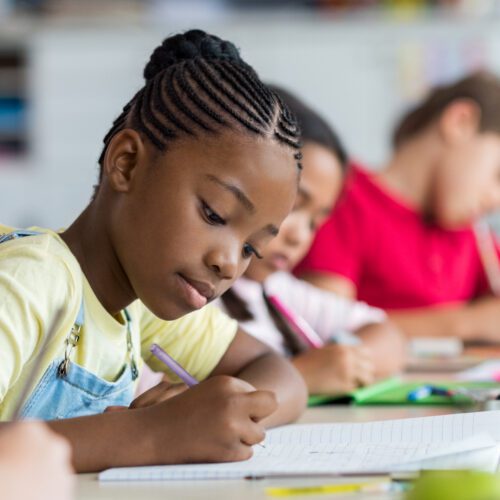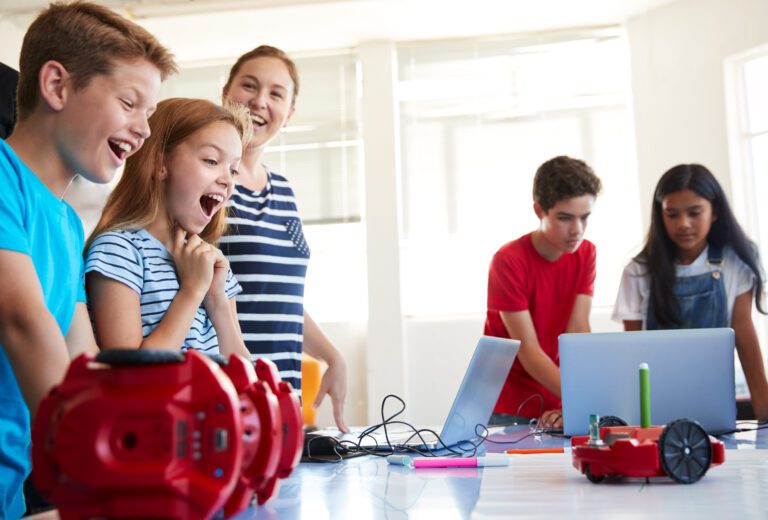
Oliver is a third grader who loves playing soccer and wants to be a firefighter someday. He gets excited about reading when he can choose from a selection of books, especially those about helping others. His teacher has noticed that Oliver is more likely to complete his comprehension check worksheets when he’s responding to these types of books. In addition, Oliver really seems to enjoy working through supplemental lessons offering adaptive literacy tools that adjust to his pace.
Sofia is an eighth-grade student who enjoys movies and plans on studying mechanical engineering in college. Her favorite part of Algebra class is when her teacher incorporates interactive problem-solving games that allow teams to compete against each other. She often volunteers to be a team leader and submit their answers during the games.
Both Oliver and Sofia are actively engaged in learning, although each responds to different strategies for building interest, motivation, and confidence. We know that engagement is critical for student achievement based on years of research. As noted in our recent Education Insights report, “when students are deeply engaged, knowledge retention improves, skills transfer, and deeper understanding takes place. These are outcomes that matter not just for end of course or grade level outcomes, but for real-world readiness.”
Ideally, each classroom in a school would be set up to meet a broad range of student engagement needs, but not everyone will know what instructional options exist and how much of a difference they can make. Let’s start by identifying what engagement is, explore strategies to strengthen it, and then look at real-world evidence that it leads to student growth in both math and reading.
What Are the Three Types of Student Engagement?
Oliver and Sofia’s stories illustrate that engagement takes many forms. Research shows it falls into three categories: cognitive, behavioral, and personal. “Cognitive” refers to thinking and learning, and it applies when students are:
- Doing critical thinking and problem solving
- Using deep learning strategies
- Setting goals and monitoring their progress
For example, giving elementary students problem-based addition and subtraction tasks helps them understand the reasoning behind the math, especially when asked to show their thinking and represent answers in more than one way.
“Behavioral” refers to what students do at school, and it applies when students are:
- Attending school consistently and on time
- Actively participating in class
- Completing assignments on time
We can see students participating in class in a variety of ways, such as asking questions when they aren’t sure what worksheet instructions mean or taking notes during a class discussion that they use to write an essay later.
“Personal” refers to how students feel about school, teachers, and peers, and it applies when students:
- Are enthusiastic and motivated to learn
- Feel connected
- Enjoy positive relationships with other students and teachers
Here, students may feel more comfortable providing answers to teacher questions in class when they know it’s ok to be wrong.
How Can We Foster Student Engagement?
Educators have many ways to establish and strengthen the three types of student engagement, such as:
- Setting clear expectations and establishing routines (cognitive)
- Including student choice and voice (cognitive)
- Using a curriculum that is challenging and culturally relevant (behavioral)
- Encouraging social learning (behavioral)
- Creating a supportive environment in the classroom (personal)
- Using frequent, timely, and specific feedback (personal)
In addition, removing barriers to learning is essential for students to make progress. This could take the form of added scaffolding, or it may involve incorporating alternative formats such as audio or video content. And rather than doing it all by themselves, teachers can lean on instructional technology solutions more than ever. For instance, adaptive tools like DreamBox Math personalize pacing and content for each student, so they stay motivated.
How Can Technology Boost Student Engagement?
Technology by itself isn’t necessarily engaging, so it’s critical that educators evaluate educational programs based on whether they include approaches proven to boost engagement. The most effective tools go beyond digitizing content and instead adapt to each learner’s needs. For example, DreamBox Reading uses real-time data to adjust instruction, giving students the right level of challenge and support while keeping them motivated. Plus, since students learn in different ways and often have strong preferences for learning, it’s best to either have a variety of tools on hand or resources that offer built-in flexibility to teach using a variety of modalities and/or content.
This translates into students discovering practical applications of knowledge, taking ownership of their learning, avoiding boredom and frustration, working at the right pace for them, and feeling that it’s ok to make mistakes—all of which can positively affect student progress to an eye-opening extent sometimes.

Real-World Success
What are some examples of technology improving student engagement?
- Real-life context aligned to curriculum, including examples, anecdotes, problem-based learning, and interviews
- Vetted, age-appropriate videos and audiobook options, supporting different styles of absorbing information
- A set of choices in assigned reading materials or methodology for solving problems, such as virtual manipulatives for math
- Game-like experiences for individual, small-group, or whole-class learning that reading comprehension or math problem-solving
- Adaptive software that personalizes learning based on student interactions, such as adjusting the difficulty level or offering different types of problems
Teachers may look to supplemental materials to strengthen student engagement, and since many are digital, they can quickly and easily implement one or more of the strategies previously mentioned.
One example of a supplemental program is DreamBox Math. It provides an interactive set of activities and adapts to each student as they progress through lessons, adjusting the level of challenge to keep learners motivated. What’s more, it closely tracks each student’s personalized learning, giving teachers insights into their progress with strengths, struggles, and opportunities for growth highlighted. Schools and districts across the country have reported significant student growth after adding DreamBox Math to their toolkit:
- Denton Public Schools: The percentage of kindergarten students proficient in math grew from 63% one year to 75% the next year
- Salem School District: Measure of Academic Progress (MAP) testing scores in 2022–2023 were some of the highest Salem had ever seen, and state testing (Wisconsin Forward) scores also improved
- Harbison West Elementary School: In one grade level, 86% of students met their MAP goal with 80% median conditional growth compared to all other grade levels (70% range)
For literacy instruction, Reading Plus provides personalized instruction and intervention for students in grades 3–12. It includes texts that reflect their own lives and experiences and texts from global sources to add to cross-curricular knowledge, giving learners choice and agency in their journey. Recent school and district successes with this solution include:
- Holman Middle School: Tier 2 students averaged two reading-level gains and Tier 3 students averaged 2.5 level gains in just their first year
- Waterford Graded School District: Students who completed 80+ lessons grew an average of 3.2 reading levels, and those who completed 100+ lessons averaged 4.0 reading-level gains
- Henderson Collegiate Middle School: In one year, the entire school saw 2.6 reading-level gains with 47% of students at or close to reading level, up from 15% previously
What to Explore Next
Even though we’ve looked at the three types of student engagement, strategies for meeting different needs, what technology has to offer, and real-world gains at schools and districts, there’s still more to learn. The 2025–2026 Education Insights report presents key findings about engagement based on feedback from thousands of K–12 superintendents, principals, teachers, parents, and students across the United States. It answers questions like “What percentage of students are bored each week?” and “How well do student and teacher observations of high student engagement match up?” Dig into the data and insights in the report to gain a better understanding of how to support stronger student engagement in your school or district.






